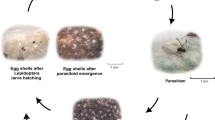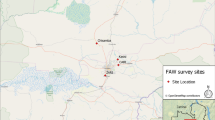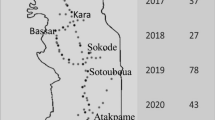Abstract
The establishment of P. truncatus in Africa has highlighted the inherent weakness of phytosanitary measures against exotic pests. Consideration is given to the need for phytosanitary measures and how patterns of international trade affect phytosanitary control. To prevent the spread of pests such as P. truncatus, large grain shipments can be subject to stringent pest control procedures. However, a significant proportion of grain movement in Africa, both within countries and across borders, occurs informally by both illicit, commercial movement of multiple truckloads of grain and legally by individuals carrying headloads via bush paths or small parcels on public transport. Attempts to locate and inspect the small lots would be impractical. Some recommendations are given on how the spread of P. truncatus in large-scale international trade can be slowed but otherwise it is accepted that in the long-term the prevention of further spread of P. truncatus in Africa is wholly unrealistic.
Similar content being viewed by others
References
Al-Sousi, A.J., El-Haidari, H.and Al-Ani, J.N.(1970) Out-breaks and Records. Iraq. Larger grain borer on maize. FAO Plant Pro. Bull. 18, 92–93.
Black, R.(2002) Phytosanitary agreements, requirements and standards. In: P. Golob, G. Farrell and J.E. Orchard (eds) Crop Post-Harvest: Science and Technology. Volume 1: Principles and Practice. Oxford: Blackwell Science.
Calderon, M. and Donahaye, E.(1962) Outbreaks and Records. Israel. First record of Prostephanus truncatus in stored grain. FAO Plant Prot. Bull. 10,43–4.
Caresche, L., Cotterell, G.S., Peachey, J.E., Rayner, R.W. and Jacques-Felix, H.(1969) Handbook for Phytosanitary Inspectors in Africa. Lagos: Organisation of African Unity/Scientific,Technical and Research Commission.
Dunstan, W.R. and Magazini, I.(1981) The larger grain borer on stored products in Tanzania. FAO Plant Prot. Bull. 29, 80–1.
Farrell, G.(2000) Dispersal, phenology and predicted abundance of the larger grain borer in different environments. Afr. Crop Sci.J. 8,337–43.
Hodges, R.J., Wright, M. and Hamilton-Peach, J.(1995) Larger grain borer - a threat to the grain trade and food security of West Africa. Report for the Commission of European Communities DGVIII. Chatham: Natural Resources Institute.
Hodges, R.J., Farrell, G. and Golob, P.(1996) Review of the Larger Grain Borer outbreak in East Africa - rate of spread and pest status. In G. Farrell, A.H. Greathead, M.G. Hill and G.N. Kibata (eds) Management of Farm Storage Pests in East and Central Africa. Proc.East Central Africa Storage Pest Management Workshop, 14-19 April 1996, Naivasha, Kenya. Ascot: International Institute of Biological Control.
IMO (1993) Recommendations for the safe use of pesticides in ships. Misc/Circ.612/Corr.1.8 September 1993. London: International Maritime Organisation.
ISO (1981) ISO 6644: 1981.Cereals and milled cereal products- automatic sampling by mechanical means. Geneva: International Organisation of Standards.
ISO (1986) ISO 6639-2:1986. Cereals and pulses-determination of hidden insect infestation-Part 2: Sampling. Geneva: International Organisation of Standards.
ISO (1999) ISO 13690:1999. Cereals, pulses and milled products -sampling of static batches Geneva: International Organisation of Standards.
Kalivogui, K.and Mück, O.(1991) Larger Grain Borer (Prostephanus truncatus )in Guinea, FAO Plant Prot. Bull. 39, 43.
Krall, S.(1984) A new threat to farm-level maize storage in West Africa. Prostephanus truncatus (Horn)(Coleoptera: Bostrichidae). Trop. Stored Prod. Inf. 50, 26–31.
OAU (1988) Inter-African Plant Phytosanitary and Plant Quarantine Regulations. OAU Scientific and Technical Research 1 (1). Yaoundé: Commission of the Inter-African Phytosanitary Council.
Semple, R.L. and Kirenga, G.I. (eds) (1994) Facilitating Regional Trade of Agricultural Commodities in Eastern, Central and Southern Afric.: Phytosanitary Standards to Restrict the Further Rapid Spread of the Larger Grain Borer (LGB)in Rhe region.FAO/NRI/CTA. Dar-es-Salaam: Dar-es-Salaam University Press.
Tyler, P.S, (1992) Larger grain borer phytosanitary report for Zambia: Implementation report August 1992. Report number R 1874. Chatham: Natural Resources Institute.
Tyler, P.S., Golob, P., Compton, J. and Bickersteth, S.(1990) Study on Phytosanitary Requirements to Promote Maize Trade in Eastern and Southern African Countries at risk from the Larger Grain Borer. Report for the Commission of European Communities DGVIII. Chatham: Natural Resources Institute.
Tyler, P.S., Walker, D.J. and Donaldson, T.J.(1994) Management of Drought Relief Maize. Technical problems encountered in Southern Africa during the 1992/93 food aid operation. Chatham: Natural Resources Institute.
Author information
Authors and Affiliations
Rights and permissions
About this article
Cite this article
Tyler, P., Hodges, R. Phytosanitary Measures Against Larger Grain Borer, Prostephanus truncatus (Horn) (Coleoptera: Bostrichidae), in International Trade. Integrated Pest Management Reviews 7, 279–289 (2002). https://doi.org/10.1023/B:IPMR.0000040816.21570.06
Issue Date:
DOI: https://doi.org/10.1023/B:IPMR.0000040816.21570.06




